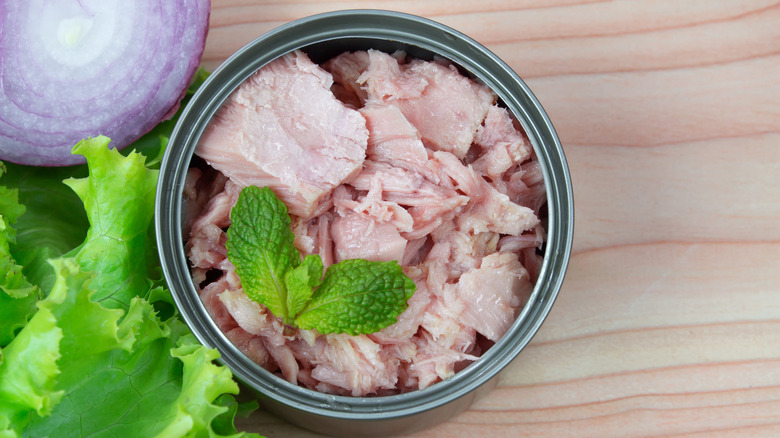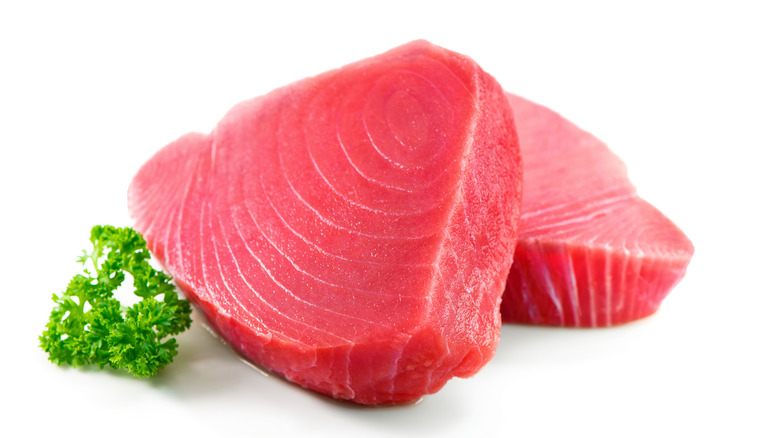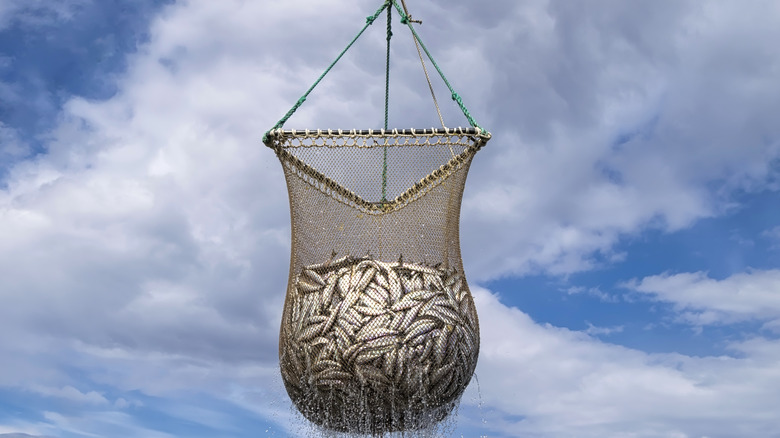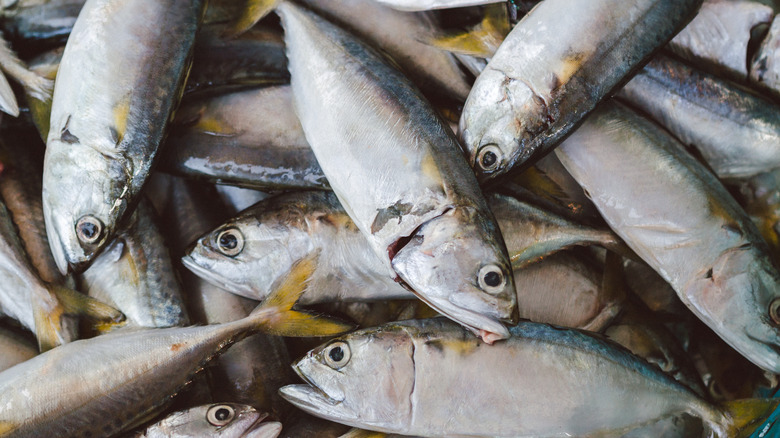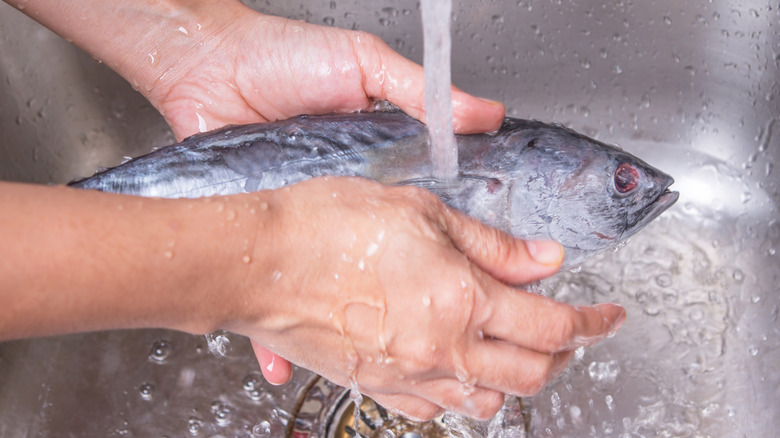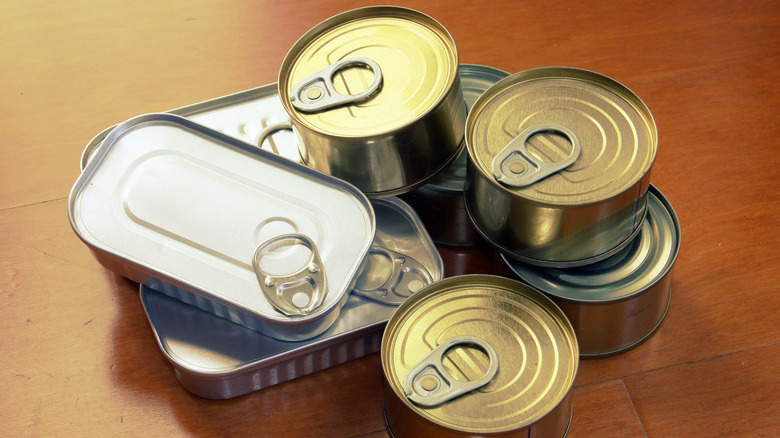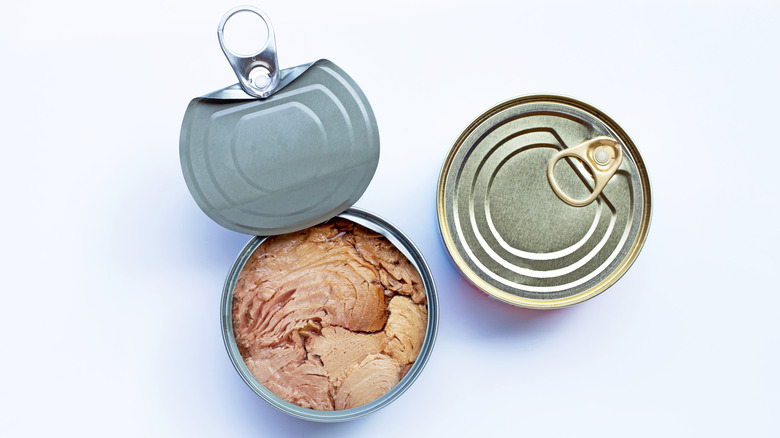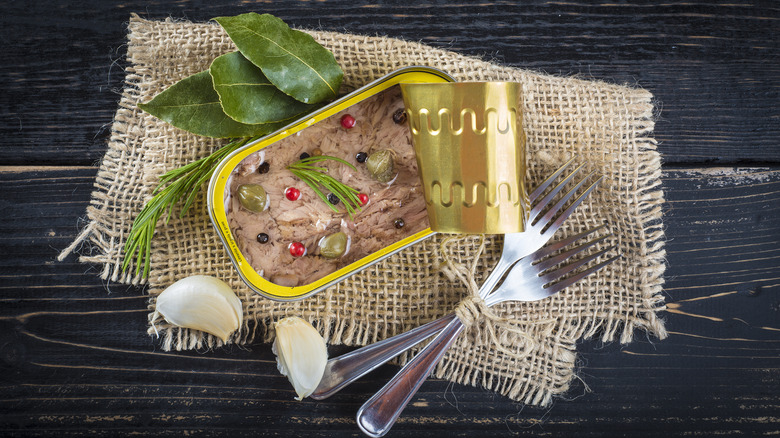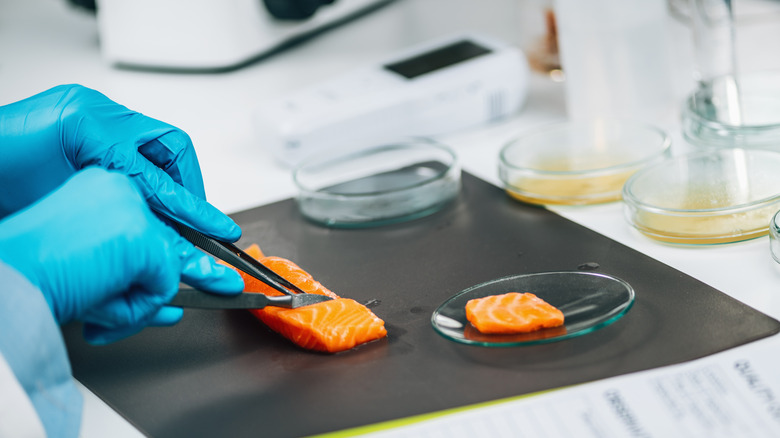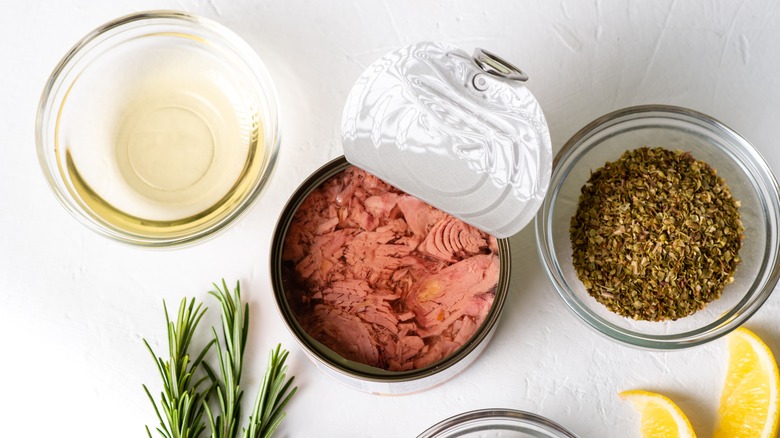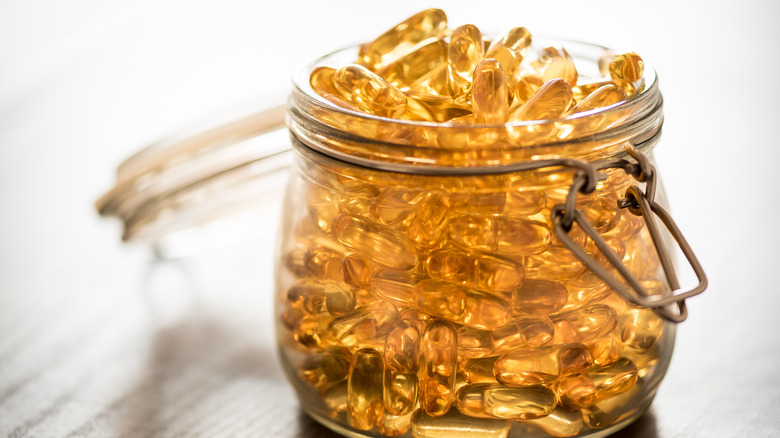This Is How Canned Tuna Is Really Made
Have you ever wondered when canned tuna became such a pantry staple? Well, canned tuna — at least, the sort we all know now that's made with albacore tuna — was first introduced to the market in 1903. Sardines, once the most commonly canned and consumed fish since the late 1800s, saw their numbers decrease dramatically as a result of over-fishing and suboptimal ocean conditions. This prompted San Pedro Bay canner Albert P. Halfhi to pack his empty sardine cans with locally-sourced albacore tuna. He sold 700 cases of the canned tuna within the first year of his experiment, and was making 400,000 cases per year by 1914.
Later, canned tuna proved particularly valuable during World War I. Demand rose so high that, by the 1920s, other species of tuna were being caught and canned. By 1954, the United States had the highest rates of tuna production and consumption in the world. Today, canned tuna is the most-consumed canned seafood in the country, although most is now imported (via Seafood Health Facts). Given its popularity over the years, the World Wildlife Fund launched the International Seafood Sustainability Foundation to advocate and develop best practices within the industry. Read on to learn more about how your canned tuna is made, a process that starts long before it makes it to your sandwich.
Diffferent species of tuna are used for canning
When it comes to the different types of tuna you can find, you are likely to immediately think of light or white tuna. That's because this is one of the clearer distinctions you'll notice in the grocery store aisle, each with its own distinct features. According to Starkist, light tuna comes from skipjack and yellowfin and is characterized by a tannish-pinkish color, soft texture, and a flavor akin to chicken thighs. On the other hand, white tuna can only be made from albacore. Contrary to what its name suggests, white tuna appears light pink and has a firmer texture and a milder flavor comparable to chicken breasts. Of the two, white tuna has a slightly higher fat content and thus higher levels of omega-3 fatty acids.
As the second-most consumed seafood in the United States, there are other species of tuna that, although not primarily earmarked for canning, are worth noting. Among these are bigeye and bluefin tuna. Bigeye tuna resembles yellowfin, only with its namesake big eyes. With a lifespan of eight years, its can reach 6.5 feet in length and is usually found in sushi or served steak-style. As for the most expensive tuna species, bluefin tuna's lifespan can go all the way to 20 years. You'd be hard-pressed to find it served any other way but in sashimi and sushi (via Seafood Health Facts).
A lot of equipment is needed to catch tuna
Pole and line fishing, as well as handlining (what fisherman do during surface trolling), are the most ecological fishing methods. Although they seem pretty straightforward, they do require much equipment. According to the Food and Agriculture Organization of the United Nations, there is a sequence of four main operations during fishing. To make things even more complicated, each kind comes with its own unique set of equipmment.
The first method involves baiting hooks, which require nets and light attraction devices for small fish and squids that will be used as bait. Frozen bait is sometimes also used, though it may not be as effective. The second focuses on school locations, which requires acoustic instruments like an echosounder. The third method demands setting handlines, which requires lines of varying lengths and hooks. Finally, the fourth tuna-wrangling method is landing catch, where fishing lures are placed under a cover that's been sprayed with undercover or boxes with ice.
In cases where the tuna that's been caught is large, it must be kept in an individual box with ice. These operations will also need to happen on a either a boat, canoe, or another kind of small vessel without a deck. What's more, the lines must also be strong enough to not only carry the fish, but to manage its escape attempts.
Some tuna fishing methods are controversial
Some of the most popular tuna fishing methods include pole and line fishing, surface trolling, longline fishing, and purse seine fishing. Pole and line fishing uses hand-held poles with short lines and baited hooks to catch tuna specifically where a school has been located. Surface trolling is when a boat slowly drags lured poles and lines across the ocean surface. Any tuna that is caught is quickly reeled in and unhooked by the fishermen aboard before the line is placed back in.
While pole and line fishing, along with trolling are specifically aimed at catching tuna, longline, purse seine fishing and gillnets are less precise. Other animals are easily caught up in these latter methods, which exceptionally harmful to the environment. While issues with bycatch centered on dolphins, it is now clear that these methods can harm other species including turtles, swordfish, and young tuna that should not be caught nor kept. The International Seafood Sustainability Foundation reported that 64% of shark catches in the Indian Ocean can be attributed to gillnet fishing. As such, it's important to check that the tuna you consume has been caught using ecologically-sound methods.
The process of cleaning and canning tuna is carefully monitored
Per Food Source Information, after tuna has been caught (hopefully using ecological and sustainable methods) and stored cold, it is thawed in water tanks, sorted according to size, and then pre-cooked in order to remove an unwanted oils. This process of pre-cooking can last anywhere between 45 minutes and three hours. Next, the tuna is left to cool, then stripped of bones and skins before the meat is separated into light and red categories. Light meat — also referred to as loins — is what's used for canning, while red meat is often used to make pet food. The loins are cleaned in preparation for canning.
During the canning process, the tuna, along with flavorings and seasonings, is placed in vacuum-sealed cans. Those cans are washed, cooked, and sterilized. This is done to make sure that any live bacteria that may still be present inside the sealed cans is completely removed. They are then left to cool before being labeled and assessed for leakage or contamination before they're declared ready for shipping and retail.
If you're already into canning your own foods, you might be wondering if you're able to can tuna at home. That's possible, though there are some rules to follow. For home canning, it's crucial that you follow the USDA home canning guide to ensure you're doing everything by the food safety book.
Tests determine how canned tuna is labelled
Once your tuna has been through the pre-canning production line, it gets labelled, a step that's based on stringent criteria (via Canned-Tuna.com). For instance, when you see the word "solid" on your can of tuna, you're getting a filleted piece of fish with small pieces added only to fill the can. The small pieces must come from the tuna loin, and the amount added cannot exceed 18% of the total contents of the can. Chunks contain a mix of differently sized tuna bits.
However, it's not as simple as just pulling pieces of tuna apart and calling it a day. That's because chunks undergo a rigorous qualifier, too, in which the tuna is pressed through a 0.5-inch mesh screen. That meat can go into the can and be labeled as chunks only if more than half of what was pressed through did not actually go through the screen.
Tuna flakes undergo a similar trial to the chunks, only this time more than half of the tuna has gone through the mesh screen. With grated tuna, all of the meat must go through the 0.5-inch mesh screen in order for it to be found worthy of making it into the "grated" can, though you must still be able to tell that the bits are separate and not a paste.
Water-packed tuna isn't necessarily better than oil-packed
For most people, the choice between water-packed and oil-packed tuna comes down to a matter of taste, perceived healthiness, or both. According to Livestrong, water-packed tuna contains 66 calories per serving, compared to the 145 calories typical of oil-packed tuna. So if caloric intake is your biggest concern, water-packed could be the best way to go. One of the greatest benefits of tuna is its richness as a source of omega-3 fatty acids. Water-packed tuna reportedly trumps the oil-packed variety in this regard. But much of that nutrient could be in the oil. According to Clean Plates, one way to get the most out of that omega-3 fatty acid-rich oil is to use it. Deploy it as an ingredient in your homemade salad dressings, for instance, or make mayo from scratch.
Oil-packed tuna also trumps water-packed when it comes to selenium and vitamin D. While half a cup of oil-packed tuna contains 55.5mcg of sellenium — which supports the body by lowering oxidative stress and inflammation while aiding immune and thyroid function (via Healthline) – the same amount of water-packed tuna contains 48.7mcg. These same amounts of oil- and water-packed tuna also contain 4.9mcg and 0.83mcg of vitamin D, respectively. Ultimately, whichever one you choose will come with its own benefits and drawbacks compared to the other. What really matters is that you enjoy your choice.
All information about seasonings is on the can
As per Canned-Tuna.com, various seasonings and flavorings can be used to make your canned tuna what it is. The phrase "packed in water" is pretty straightforward. However, different types of vegetable oil can be used to make oil-packed tuna. Some of these include soybean oil, sunflower oil, and canola oil — just as long as it's not olive oil. Tuna packed in olive oil will usually be specified as such on the packaging, and may even be labelled "Tonno."
Once the above distinctions are made, other seasongs and flavorings can be added to the mix. Among these are spices, along with extracts and oils that can include salt, lemon flavoring, garlic, MSG, and hydrolized protein. Vegetable broths are also a cook feature here, though they must contain at least two vegetables from a specific list, such as beans, carrots, cabbage, celery, or bell peppers.
Surprisingly enough, vegetable oil can also be a flavoring in water-packed tuna. However, it can only make up 5% of the total can contents in order for it to qualify as water-packed. In cases where the tuna is smoked, similarly to olive oil-packed tuna, it will be marked accordingly.
Knowing how to store canned tuna is important
The safety of canned foods is paramount, more so even than our enjoyment of any food we consume. Canned tuna is no exception. Given the rigorous sterilization processes used during canning, sealed tuna cans are about as safe from food-borne disease as a food can be, per Food Source Information. This means that any dates regarding a can's "best by" or "sell by" deadlines are more about the quality of the tuna rather than its safety. For home canning, however, food safety is dependent on how closely the canner follows canning and sterilization guidelines.
According to the National Fisheries Institute, you can help maintain the quality of your canned tuna by storing the cans at room temperature and keeping them off the floor. Try placing older cans in front of newer ones in your pantry in order to remind yourself to use the older ones first. Perhaps most importantly, if you notice any damage, swelling, or rust on a can of tuna, do not consume it. This could signal contamination of some kind. If you're ever in any doubt about canned tuna or any other foods in your kitchen, you can always access the USDA guide to food safety and handling to be extra sure.
Some tuna has been auctioned for millions of dollars
In 2019, the BBC reported that Japanese sushi boss and self-proclaimed tuna king Kiyoshi Kimura paid $3.1 million for a 612-pound bluefin tuna at Topkyo's first fish market auction of the year. At the time, Kimura had already been the highest bidder for seven out of eight years. This time, he paid more than twice his already mind-boggling 2013 bid of $1.4 million. Such a high bid for the bluefin, which is listed as an endangered species by the World Wildlife Fund, was reportedly a status symbol, given how low bluefin catches had been in the previous year.
According to Rarest, there are several other expensive tunas that deserve mention. Firstly,"sashimi-grade" albacore tuna can be served as a mid-range luxury dish, with fillets as big as 10 pounds going for $195. Sashimi-grade albacore is exceptionally rare, as it's of such high quality that it can be eaten raw. Although, like lower grades of albacore, yellowfin tuna is also commonly canned, high quality varieties of this tuna can go $30 per pound, with maximum weights of up to 400 pounds. Skin-off bigeye tuna (specifically from French Polynesia) go all the way up $64 per pound, also with maximum weights of up to 400 pounds.
Here's how you can prepare canned tuna at home
Tuna salad sandwiches, tuna melts, tuna casseroles, tuna salads ... these are the usual suspects you'll find at the table when you catch a whiff of canned tuna. However, there are plenty of ways to quite literally spice up your tuna salad. For instance, you can give it a tinge of warmth with a curry powder blend containing curry leaf, turmeric, cardamom, and cumin, for instance. You can also sample the sweetness of dill or the zesty kick of lemon pepper. If you don't have lemon pepper on hand, you can easily make your own by grinding up sea salt, pepper, and lemon zest.
According to Greatist, you can also add a bit of razzle to your tuna salad by foregoing the traditional mayo entirely and instead adding mustard, Greek yogurt or sour cream, hummus, or even vinegar. Consider adding texture with chopped nuts, seeds, and crunchy fruits (like pears) and vegetables. Other creative ways of preparing your canned tuna include using it in warm pastas, white bean soups, tuna cakes or burgers, and incorporating it in a tonnato sauce for bread or appetizers (via VICE). The possibilities here are practically endless, really. It's just a matter of thinking outside the box — or in this case, outside the can.
Canned tuna must be consumed in moderation
According to BBC Good Food, 100 grams of canned tuna contains about the same nutrients as the same weight of fresh tuna. For starters, you'll get about 24.9g of protein from a 100g can of tuna. That's quite significant, considering the daily protein intake for the average sedentary man is 56-91g, and 46-75g for women (via Healthline). It's also a valuable source of amino acids, B vitamins, calcium, magnesium, and vitamin D. These help to protect you from heart disease, and support the health of your skin, bones, and brain. When it's packed in brine or water, canned tuna is also low in fat. Combined with its high protein content, this nutrition profile can aid in weight management.
While canned tuna does boast an impressive profile of health benefits, moderation is still key. Per Eat This, Not That!, one can of tuna contains about a quarter of one's naily recommended amount of sodium. Now, sodium is not inherently bad for you. In fact, your body needs it to support the contraction and relaxation of muscle, regulate your balance of water and minerals, and maintain nerve function (via Harvard School of Public Health). However, when consumed in high quantities, it can lead to bloating and, over the long term, can increase your risk of heart disease, stroke, and high blood pressure.
What about mercury?
We cannot consider the health benefits of tuna without considering the potential dangers of mercury. This potential contaminant is another reason why moderation is key when it comes to eating tuna. According to Healthline, mercury seeps into marine life through natural and manmade industrial processes that emit mercury into the atmosphere and ocean water. Because tuna feeds on other, smaller fish that already contain mercury, it ends up collecting more of this heavy metal than many other seafood animals — a persistent issue for large, predatory, oceangoing fish. For instance, 85g of light tuna can contain a mercury concentration of about 10.71mcg, while the same amount of albacore tuna can contain about 29.75mcg.
Given that the EPA advises that you only consume a maximum of 0.045mcg of mercury per pound of body weight in a week (via Healthline), one 85g serving of albacore tuna contains a serious dose of the stuff. Consuming more of this toxin than your body can handle will potentially result in mercury poisoning. Per VICE, symptoms of milder cases of mercury poisoning include coloring in the cheeks, swelling, itching, burning, or even feeling like insects are crawling under the skin. More serious cases are signified by heightened blood pressure, lowered cognitive function, and lung, kidney, and visual impairments.
